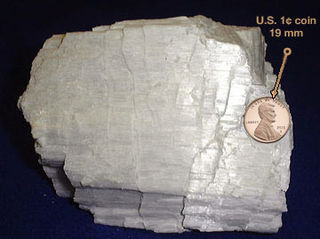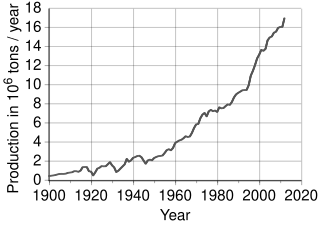China stone (occasionally Cornish stone or Cornwall stone) is a medium grained, feldspar-rich partially kaolinised granite characterised by the absence of iron-bearing minerals. [1]
Its mineral content includes quartz, feldspar and mica; accessory minerals include kaolinite and fluorspar. It is found in one area near St Austell, Cornwall in the United Kingdom. It was the last UK sourced feldspathic material to be commercially extracted. [2]
A number of varieties, named on the basis of their hardness and physical appearance, were produced. [3] Maximum production was achieved in the early 1950s, with around 70,000 tonnes per annum. The largest producer, English China Clays, ceased production in 1973, when Goonvean Ltd became the sole producer. Due to increasing competition from imported alternatives and a contracting domestic market, sales fell from 8,000 tonnes per year to 2,800 tonnes in 2001. [4] [5] The last quarry closed in 2006. [6]
Relatively similar material has been mined, and exported to England for ceramics use, in the Isle of Man and Jersey. [7] [8] [9] [10] [11] [12]
China stone is sometimes confused with the Chinese material traditionally known as petuntse as well as other Asian pottery stones. However, although somewhat similar they differ in mineralogy.

Feldspars are a group of rock-forming aluminium tectosilicate minerals, also containing other cations such as sodium, calcium, potassium, or barium. The most common members of the feldspar group are the plagioclase (sodium-calcium) feldspars and the alkali (potassium-sodium) feldspars. Feldspars make up about 60% of the Earth's crust, and 41% of the Earth's continental crust by weight.

Flint, occasionally flintstone, is a sedimentary cryptocrystalline form of the mineral quartz, categorized as the variety of chert that occurs in chalk or marly limestone. Flint was widely used historically to make stone tools and start fires.

Slate is a fine-grained, foliated, homogeneous metamorphic rock derived from an original shale-type sedimentary rock composed of clay or volcanic ash through low-grade regional metamorphism. It is the finest grained foliated metamorphic rock. Foliation may not correspond to the original sedimentary layering, but instead is in planes perpendicular to the direction of metamorphic compression.

Porcelain is a ceramic material made by heating raw materials, generally including kaolinite, in a kiln to temperatures between 1,200 and 1,400 °C. The greater strength and translucence of porcelain, relative to other types of pottery, arises mainly from vitrification and formation of the mineral mullite within the body at these high temperatures. End applications include tableware, decorative ware such as figurines, and in technology and industry such as electrical insulators and laboratory ware.

Petuntse, also spelled petunse and bai dunzi, baidunzi, is a historic term for a wide range of micaceous or feldspathic rocks. However, all will have been subject to geological alteration of igneous rocks that result in materials which, after processing, are suitable as an ingredient in some ceramic formulations. The name means "little white bricks", referring to the form in which it was transported to the potteries.

Nepheline syenite is a holocrystalline plutonic rock that consists largely of nepheline and alkali feldspar. The rocks are mostly pale colored, grey or pink, and in general appearance they are not unlike granites, but dark green varieties are also known. Phonolite is the fine-grained extrusive equivalent.

Stoneware is a rather broad term for pottery fired at a relatively high temperature. A modern definition is a vitreous or semi-vitreous ceramic made primarily from stoneware clay or non-refractory fire clay. End applications include tableware, decorative ware such as vases.

Wollastonite is a calcium inosilicate mineral (CaSiO3) that may contain small amounts of iron, magnesium, and manganese substituting for calcium. It is usually white. It forms when impure limestone or dolomite is subjected to high temperature and pressure, which sometimes occurs in the presence of silica-bearing fluids as in skarns or in contact with metamorphic rocks. Associated minerals include garnets, vesuvianite, diopside, tremolite, epidote, plagioclase feldspar, pyroxene and calcite. It is named after the English chemist and mineralogist William Hyde Wollaston (1766–1828).

Bone china is a type of ceramic that is composed of bone ash, feldspathic material, and kaolin. It has been defined as "ware with a translucent body" containing a minimum of 30% of phosphate derived from animal bone and calculated calcium phosphate. Bone china is the strongest of the porcelain or china ceramics, having very high mechanical and physical strength and chip resistance, and is known for its high levels of whiteness and translucency. Its high strength allows it to be produced in thinner cross-sections than other types of porcelain. Like stoneware, it is vitrified, but is translucent due to differing mineral properties.

Mining in Japan is minimal because Japan does not possess many on-shore mineral resources. Many of the on-shore minerals have already been mined to the point that it has become less expensive to import minerals. There are small deposits of coal, oil, iron and minerals in the Japanese archipelago. Japan is scarce in critical natural resources and has been heavily dependent on imported energy and raw materials. There are major deep sea mineral resources in the seabed of Japan. This is not mined yet due to technological obstacles for deep sea mining.
Industrial resources (minerals) are geological materials that are mined for their commercial value, which are not fuel (fuel minerals or mineral fuels) and are not sources of metals (metallic minerals) but are used in the industries based on their physical and/or chemical properties. They are used in their natural state or after beneficiation either as raw materials or as additives in a wide range of applications.
This is a list of pottery and ceramic terms.

Peak copper is the point in time at which the maximum global copper production rate is reached. Since copper is a finite resource, at some point in the future new production from mining will diminish, and at some earlier time production will reach a maximum. When this will occur is a matter of dispute. Unlike fossil fuels, copper is scrapped and reused, and it has been estimated that at least 80% of all copper ever mined is still available.

Natural resource economics deals with the supply, demand, and allocation of the Earth's natural resources. One main objective of natural resource economics is to better understand the role of natural resources in the economy in order to develop more sustainable methods of managing those resources to ensure their availability for future generations. Resource economists study interactions between economic and natural systems, with the goal of developing a sustainable and efficient economy.
Resources are classified as either biotic or abiotic on the basis of their origin. The Indian landmass contains a multitude of both types of resource and its economy, especially in rural areas, is heavily dependent on their consumption or export. Due to overconsumption, they are rapidly being depleted.

Mining in the United Kingdom produces a wide variety of fossil fuels, metals, and industrial minerals due to its complex geology. In 2013, there were over 2,000 active mines, quarries, and offshore drilling sites on the continental land mass of the United Kingdom producing £34bn of minerals and employing 36,000 people.

The LASSELSBERGER Group is an international producer of raw materials, building materials and tiles based in Pöchlarn. Both local home markets and international markets - especially in Western Europe - are supplied from the production sites in Central and Eastern Europe. The subsidiaries of the three divisions Ceramics, Building Materials and Minerals as well as the local organizations are managed and coordinated from Pöchlarn. The term "LASSELSBERGER Group" represents the umbrella term for all corporate components of Lasselsberger GmbH.

Jacobsville Sandstone is a red sandstone formation, marked with light-colored streaks and spots, primarily found in northern Upper Michigan, portions of Ontario, and under much of Lake Superior. Desired for its durability and aesthetics, the sandstone was used as an architectural building stone in both Canada and the United States. The stone was extracted by thirty-two quarries throughout the Upper Peninsula of Michigan approximately between 1870 and 1915.
Carborundum Universal Ltd (CUMI), a part of Murugappa Group, is one of the largest and oldest conglomerates in India. CUMI is the leading manufacturer and developer of abrasives, ceramics, refractories, aluminium oxide grains, machine tools, polymers, adhesives and electro minerals in India.

The mining industry of Yemen is at present dominated by fossil mineral of petroleum and liquefied natural gas (LNG), and to a limited extent by extraction of dimension stone, gypsum, and refined petroleum. Reserves of metals like cobalt, copper, gold, iron ore, nickel, niobium, platinum-group metals, silver, tantalum, and zinc are awaiting exploration. Industrial minerals with identified reserves include black sands with ilmenite, monazite, rutile, and zirconium, celestine, clays, dimension stone, dolomite, feldspar, fluorite, gypsum, limestone, magnesite, perlite, pure limestone, quartz, salt, sandstone, scoria, talc, and zeolites; some of these are under exploitation.